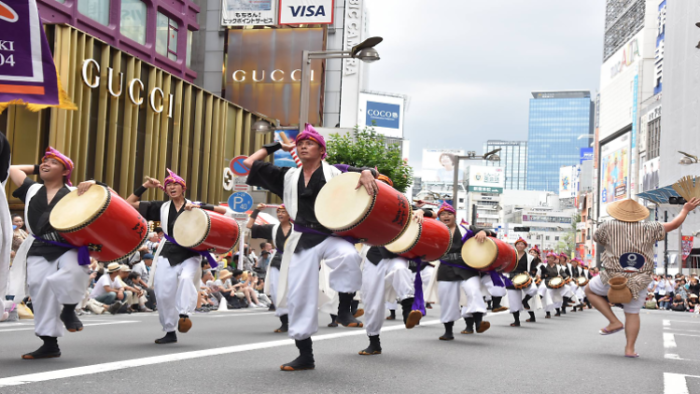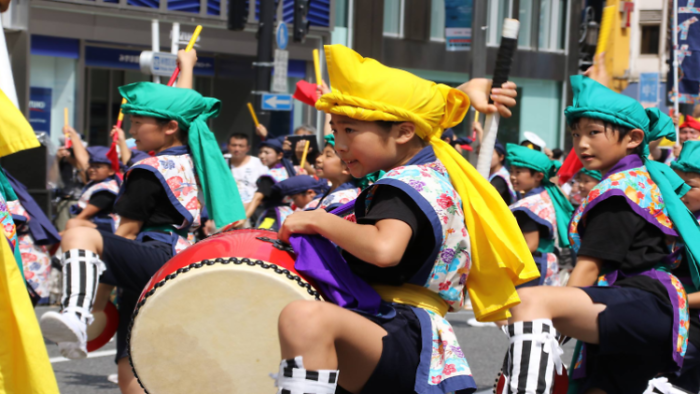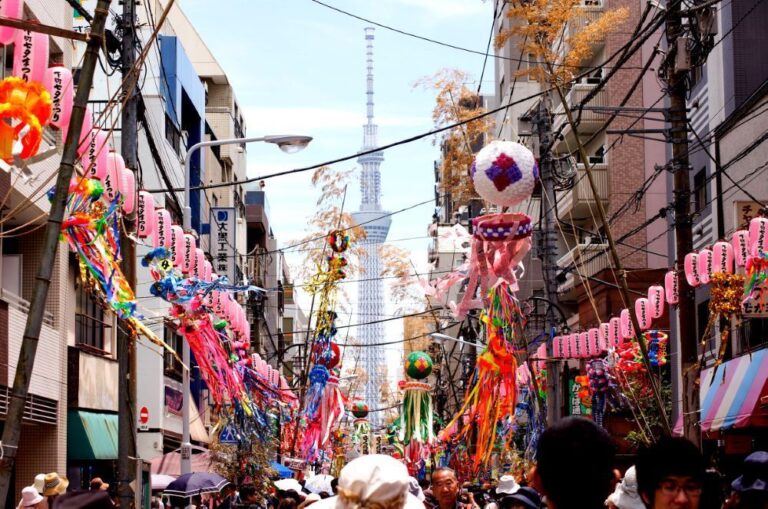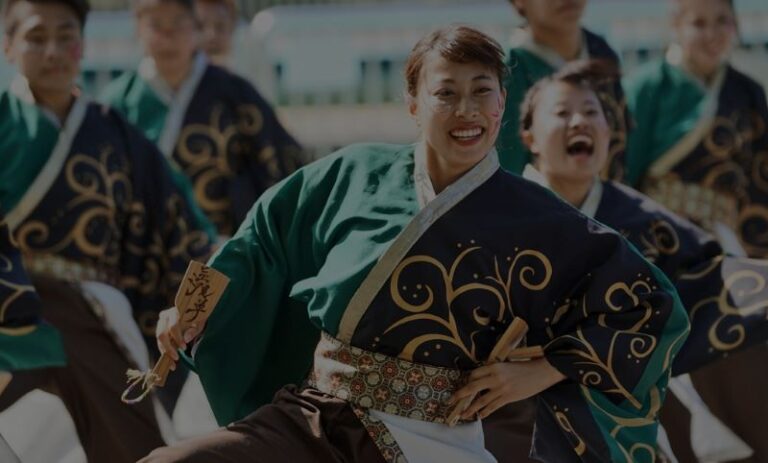The Shinjuku Eisa Festival, held annually in Tokyo’s vibrant Shinjuku district, showcases the captivating dance and tradition of Okinawa.
On July 29th, thousands of spectators gather to witness the mesmerizing Eisa dance performances, a unique folk dance that originated during the Bon period.

Snaking processions of brightly-hued Eisa dancers, with portable taiko drums in tow, captivate onlookers at Shinjuku Station’s east exit.
This free-to-attend event offers a cultural exchange experience, leaving participants and spectators with unforgettable memories of the vibrant spirit of Okinawan culture.
Key Takeaways
- The Shinjuku Eisa Festival is an annual event in Tokyo’s Shinjuku district that showcases Okinawan tradition and culture through Eisa dance performances.
- Eisa dance originated from Okinawa’s Obon traditions and honors ancestors’ spirits through music and dance, with performers wearing striking traditional attire and unique drumming styles accompanying the dance.
- The festival features brightly-hued processions of Eisa dancers that snake through Shinjuku Station’s east exit, with live performances setting an upbeat tempo and captivating onlookers with portable taiko drums and expressive dancing.
- The festival provides a taste of Okinawan culture in Tokyo and offers a cultural exchange experience, combining dynamic beats and colorful dances, and creating an exciting Tokyo event in July that leaves participants and spectators with unforgettable memories.
What is it?

The Shinjuku Eisa Festival is a free-to-attend event that showcases the unique and vibrant tradition of Okinawan dance and culture. With a rich history and evolution, the festival has become one of the most anticipated events in Tokyo.
Originating from Okinawa’s Obon traditions, Eisa dance honors ancestors’ spirits through music and dance. Over the years, this unique folk dance has gained popularity within the Japanese cultural landscape and can now be enjoyed in different parts of the country.
The Shinjuku Eisa Festival serves as a platform to bridge Tokyo and Okinawa cultures, attracting over a million spectators annually. Witnessing the brightly-hued processions of Eisa dancers, accompanied by unique drumming styles, is a captivating experience.
This vibrant festival has become a symbol of cultural exchange and celebration, creating an exciting Tokyo event in July.
Origins and Significance
Originating from Okinawa’s Obon traditions, this unique folk dance honors ancestors’ spirits through music and dance.
- Historical Background: The Eisa dance originated during the Bon period in Okinawa. It gained popularity within the Japanese cultural landscape and can now be enjoyed in different parts of the country.
- Ancestral Honoring: Performers of Eisa dance wear striking traditional attire and use unique drumming styles to accompany their movements. This dance form serves as a way to pay tribute to and remember ancestors.
- Cultural Significance: The Shinjuku Eisa Festival, held annually in Tokyo’s Shinjuku district, attracts over a million spectators each year. The festival features Eisa dancers creating brightly-hued processions, with live performances captivating onlookers. It is a vibrant celebration that bridges Tokyo and Okinawa cultures, offering a taste of Okinawan tradition and creating a cultural exchange experience.
Processions and Performances

Participants in the Shinjuku Eisa Festival create vibrant processions that wind their way through the streets, captivating onlookers with their expressive dancing and the rhythmic beats of portable taiko drums.
The Eisa dance procession is a mesmerizing sight to behold, with performers donning traditional attire and showcasing intricate choreography. These processions snake through the streets of Shinjuku, bringing a burst of color and energy to the city.
The highlight of the festival, however, is the spectacular drumming performances. The portable taiko drums produce thunderous beats that resonate throughout the festival grounds, creating a pulsating rhythm that infuses the air with excitement.
The combination of the dancers’ graceful movements and the powerful drumming creates an immersive experience that leaves a lasting impression on all who witness it.
Shinjuku’s Vibrant Atmosphere
Shinjuku’s vibrant atmosphere comes alive during the festival, with the bustling streets filled with the sounds of lively music and the colorful sights of performers in traditional attire.
The Shinjuku Eisa Festival not only showcases the rich cultural heritage of Okinawan dance and tradition but also adds to the already lively nightlife scene in Shinjuku.
As the sun sets and the festival lights illuminate the streets, the energy in the air becomes palpable. Spectators and participants alike are immersed in a sensory experience, as the rhythmic beats of the taiko drums reverberate through the crowd.
The festival creates a unique fusion of traditional and modern elements, making it an event that truly captures the spirit of Shinjuku and its vibrant nightlife.
Cultural Exchange Experience
The cultural exchange experience at the Shinjuku Eisa Festival allows participants and spectators to immerse themselves in a dynamic fusion of beats and dances, creating an unforgettable and immersive event.
This festival serves as a platform for cultural fusion, showcasing the vibrant spirit of Okinawan dance and tradition.
The rhythmic beats of the traditional taiko drums, combined with the energetic and expressive movements of the dancers, create a mesmerizing spectacle that engages all the senses.
The festival’s lively atmosphere and vibrant colors transport attendees to a different world, where they can experience the rich heritage of Okinawan culture.
Whether you are a participant or a spectator, the Shinjuku Eisa Festival promises to be an immersive experience that celebrates the beauty and diversity of cultural exchange.
Convenient Location
Located in the heart of Tokyo, the Shinjuku Eisa Festival offers a convenient location for both locals and tourists to enjoy the vibrant cultural celebration.
The festival is easily accessible via public transportation, with Shinjuku Station serving as a major hub for multiple train lines. Visitors can conveniently arrive at the festival area using JR Yamanote, Keio, Odakyu Odawara, Toei Oedo, and Tokyo Metro Marunouchi lines.
The festival’s location near Shinjuku Gyoen, a beautiful park known for its cherry blossoms, adds to its charm. After immersing themselves in the lively atmosphere of the festival, visitors can explore Shinjuku’s diverse culinary and nightlife scene, enhancing their overall experience.
With its central location and easy access to public transportation, the Shinjuku Eisa Festival promises a hassle-free and enjoyable cultural event.
Unforgettable Memories
Immersing themselves in the lively atmosphere, participants and spectators of the Shinjuku Eisa Festival are left with unforgettable memories of the electrifying energy and cultural fusion. The festival showcases the vibrant spirit of Okinawan culture, combining dynamic beats and colorful dances.
The rhythmic sounds of traditional drumming fill the air as performers, adorned in striking attire, captivate onlookers with their expressive movements. The festival creates a unique experience, engaging all senses and leaving a lasting impression.
To illustrate the visual imagery, imagine a table with three columns and four rows. In the first column, there are rows of portable taiko drums, their vibrant colors reflecting the joyful ambiance. In the second column, Eisa dancers in their traditional costumes dance gracefully, their movements synchronized perfectly. And in the third column, spectators from all walks of life join in the celebration, their smiles reflecting the shared enjoyment of this cultural fusion.
Frequently Asked Questions
Are there any age restrictions for attending the Shinjuku Eisa Festival?
There are no age restrictions for attending the Shinjuku Eisa Festival. People of all ages can enjoy the festival atmosphere, making it a family-friendly event where everyone can participate and create lasting memories.
Are there any opportunities for audience participation during the Eisa dance performances?
Opportunities for audience participation during the Eisa dance performances at the Shinjuku Eisa Festival include joining in the processions, learning basic dance steps, and playing handheld instruments. The festival also features other cultural performances to engage and entertain the spectators.
Can visitors bring their own food and drinks to the festival?
Visitors to the Shinjuku Eisa Festival can enjoy local food vendors offering a variety of delicious treats. While bringing outside food and drinks may not be allowed, picnic areas are available for a relaxing dining experience.
Are there any recommended spots to get a good view of the Eisa dance processions?
Recommended viewpoints for the Eisa dance processions at the Shinjuku Eisa Festival include Shinjuku Station’s east exit and the streets surrounding it. These spots offer the best photo opportunities to capture the vibrant and energetic performances.
Is there any specific dress code for attending the Shinjuku Eisa Festival?
There is no specific dress code for attending the Shinjuku Eisa Festival. However, it is recommended to wear comfortable clothing and shoes as the festival involves a lot of walking and standing. It is also important to respect the cultural traditions and etiquette of the event.
Conclusion
In conclusion, the Shinjuku Eisa Festival is a vibrant and captivating event that showcases the rich traditions of Okinawan dance. The Eisa dance, with its origins dating back to the Bon period, has become an integral part of Japanese culture. The festival’s processions and performances through Shinjuku Station’s east exit are a sight to behold. Onlookers are captivated by the expressive dancing and portable taiko drums.
The festival’s location in Shinjuku, with its vibrant atmosphere and nearby attractions like Shinjuku Gyoen park, makes it a convenient and unforgettable cultural experience.




